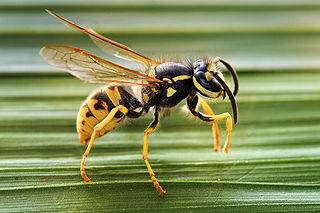
The Vespidae are a large, diverse, cosmopolitan family of wasps, including nearly all the known eusocial wasps and many solitary wasps. Each social wasp colony includes a queen and a number of female workers with varying degrees of sterility relative to the queen. In temperate social species, colonies usually last only one year, dying at the onset of winter. New queens and males (drones) are produced towards the end of the summer, and after mating, the queens hibernate over winter in cracks or other sheltered locations. The nests of most species are constructed out of mud, but polistines and vespines use plant fibers, chewed to form a sort of paper. Many species are pollen vectors contributing to the pollination of several plants, being potential or even effective pollinators, while others are notable predators of pest insect species, and a few species are invasive pests.

Paper wasps are vespid wasps and typically refers to members of the vespid subfamily Polistinae, though it often colloquially includes members of the subfamilies Vespinae and Stenogastrinae, discussed elsewhere, which also make nests out of paper. Paper wasp nests are characterized by open combs with down pointing cells. Some types of paper wasps are also sometimes called umbrella wasps, due to the distinctive design of their nests.

Polistes is a cosmopolitan genus of paper wasps and the only genus in the tribe Polistini. Vernacular names for the genus include umbrella wasps, coined by Walter Ebeling in 1975 to distinguish it from other types of paper wasp, in reference to the form of their nests, and umbrella paper wasps. Polistes is the single largest genus within the family Vespidae, with over 200 recognized species. Their innate preferences for nest-building sites leads them to commonly build nests on human habitation, where they can be very unwelcome; although generally not aggressive, they can be provoked into defending their nests. All species are predatory, and they may consume large numbers of caterpillars, in which respect they are generally considered beneficial.

The side-striped jackal is a canine native to central and southern Africa.
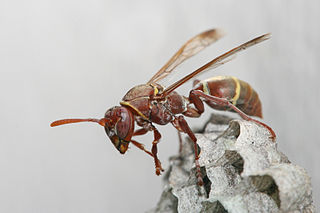
The Polistinae is a subfamily of eusocial wasps belonging to the family Vespidae. They are closely related to the wasps and true hornets of the subfamily Vespinae, containing four tribes. With about 1,100 species total, it is the second-most diverse subfamily within the Vespidae, and while most species are tropical or subtropical, they include some of the most frequently encountered large wasps in temperate regions.

Charles Thomas Bingham was an Irish military officer and entomologist.

The Luzon short-nosed rat is a species of rodent in the family Muridae. It is the only species in the genus Tryphomys. It is found only in the Philippines, and is known only from Benguet, Laguna, and Tarlac provinces.
Brienomyrus is a genus of small elephantfish in the family Mormyridae from Africa. Usually available in the pet trade, these fish are commercially referred to as baby whales or baby whalefish.
Mataeocephalus is a genus of rattails.

Polistes carnifex, commonly known as the executioner wasp or executioner paper wasp, is a neotropical vespid wasp in the cosmopolitan genus Polistes.

Polistes nimpha is a eusocial paper wasp found all over Europe, with particular sightings in Turkey, Finland, Estonia, and Latvia. It is also found in northern Africa, Pakistan, Iran, India, Kazakhstan, Mongolia, and China. The climate in these areas is relatively cold and snowy in the winter, while summers are usually hot and dry, with steppe vegetation. Polistes nimpha colonies are relatively small and easily manipulated.

Polistes canadensis is a species of red paper wasp found in the Neotropical realm. It is a primitively eusocial wasp as a member of the subfamily Polistinae. A largely predatory species, it hunts for caterpillar meat to supply its colony, often supplementing its developing larvae with nectar. The most widely distributed American species of the genus Polistes, it colonizes multiple combs, which it rears year-round.

Polistes semenowi is a species of paper wasp in the genus Polistes that is found in southeastern and southern central Europe, as well as central Asia, and was until 2017 erroneously known by the name Polistes sulcifer, while a different species was incorrectly believed to represent P. semenowi. It is one of only four known Polistes obligate social parasites, sometimes referred to as "cuckoo paper wasps", and its host is the congeneric species Polistes dominula. As an obligate social parasite, this species has lost the ability to build nests, and relies on the host workers to raise its brood. P. semenowi females use brute force, followed by chemical mimicry in order to successfully usurp a host nest and take over as the queen.
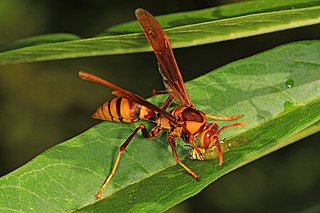
Polistes major is a Neotropical species of paper wasp found from South America north into the southern United States. This species is known as avispa de caballo in the Dominican Republic.
The name cuckoo paper wasp refers to a monophyletic species group of brood-parasitic paper wasps in the genus Polistes. This species group contains only four species; Polistes atrimandibularis, P. austroccidentalis, P. maroccanus, and P. semenowi, all of them obligate social parasites of other Polistes species.
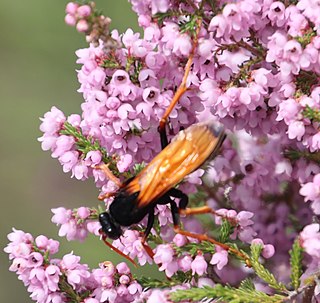
Hemipepsis is a genus of large pepsine spider wasps found throughout the tropics. They are commonly known as tarantula hawks. Hemipepsis wasps are morphologically similar to the related genera Pepsis and Entypus, but distinguishable by the pattern of wing venation. In South Africa 18 plant species from three plant families, the Apocynaceae, Orchidaceae, and Asparagaceae subfamily Scilloideae are pollinated exclusively by Hemipepsis wasps.

Afroeurydemus is a genus of leaf beetles in the subfamily Eumolpinae, found in Africa. The genus was separated from Eurydemus in 1965 by Brian J. Selman, who moved all African species of Eurydemus he had seen to this genus or related African genera and considered it likely that Eurydemus was restricted to Fiji. Many species were also originally placed in Syagrus.
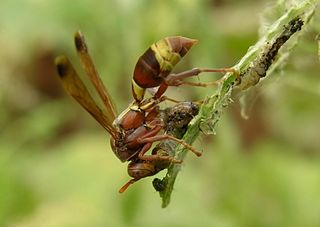
Polistes stigma is a species of paper wasp from the Paleotropics.
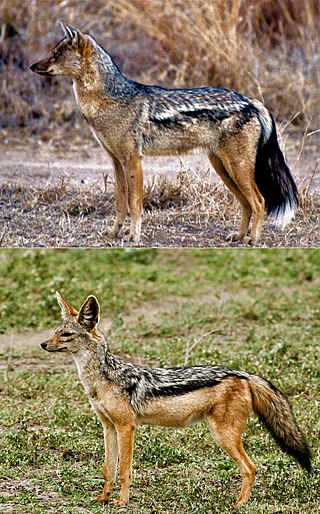
Lupulella is a genus of canine found in Africa. This genus consists of only two extant species, the black-backed jackal and the side-striped jackal.
Osmia adae is a species of bees within the genus Osmia, also known as mason bees, in the Megachilidae family.
















